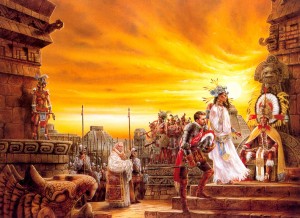This never comes up in D&D gameplay, but I have a theory that most D&D games take place under a sun that’s dimmer and more orange than ours.
 This has to do with D&D’s place in the Dying Earth sci-fi genre. D&D was largely inspired by Jack Vance, especially the Dying Earth stories, in which a far-future Earth lived its last days under a dying red sun. In this world, civilizations had risen and fallen millions of times, and there were ruins everywhere you looked.
This has to do with D&D’s place in the Dying Earth sci-fi genre. D&D was largely inspired by Jack Vance, especially the Dying Earth stories, in which a far-future Earth lived its last days under a dying red sun. In this world, civilizations had risen and fallen millions of times, and there were ruins everywhere you looked.
For contrast, look at our world. Spinning along merrily under a young yellow sun is our brand new civilization. We’re the first Earthlings to surpass D&D’s renaissance-level technology, and we’ve only got a few centuries of high technology under our belts. We’re only a few thousand years removed from humanity’s first mastery of bronze and iron.
Your average D&D world is somewhere between our living and Vance’s dying Earth. It’s in a Renaissance-technology dark age, and it lives among the ruins of more magically and technologically advanced empires. Lots of them. Many campaigns have their own lore about human and humanoid empires, and lots of editions have hints of aeons where other creatures ruled the world – dragons, demons, giants, yuan-ti, aboleth, the Queen of Chaos, all in turn. Archaological sites are not rare. In fact, there’s an undisturbed dungeon, a relic of a past age, just outside the PCs’ starting town.
Your average D&D world has been around for a while. It’s possible that its best days are behind it. If you travel into its future for a few millenia, you’ll get to Dark Sun’s red-tinged wasteland. If you travel into the past? who knows, you might end up in d20 Modern, under a garish yellow sun.








I like this idea! I would totally play with this idea in setting design sometime.
…also I am apparently now going to yammer on for awhile. I apologize in advance, as I am certain much of this is well known to you.
Vance is only one reason for all the crumbled empires among D&D’s early influences. It’s also clear in the 2e DMG (the earliest one that I’ve read in depth) that the writers had a more-than-passing familiarity with the Byzantine Empire – a Roman empire perpetually beset by marauding hordes. (Citation: check out the descriptions of armored horse archers. This is a uniquely Byzantine feature for hundreds of years. My source is Edward Luttwak’s Grand Strategy of the Byzantine Empire.)
From Constantinople, everywhere you looked (except possibly north) held the ruins of empire: to the far west was Rome, sacked many times (and its ruins covered Spain, France, England, parts of Germany, and North Africa); to the southwest was Carthage, which Rome had seen to in its own time; near at hand to the south was Greece and the ruins of Alexander’s empire; and to the southeast was Mesopotamia, with more empires per square foot than any other part of the known world. It’s kind of the ideal D&D setting, but I’ve only rarely seen anyone completely embrace it as source material.
Interesting post, I do tend to like these. This specific suggestion reminds me of the civilization in Anathem which has flowed and ebbed for time uncounted.
But I do have a possible argument that D&D world’s might live under a red sun…
From an “astronomical” perspective the cooler the star the longer its lifetime, some red dwarf stars have expected lifetimes on the order of trillions (yes!) of years. Enough time for civilizations to arise, depart for the stars, collapse, evolve, arise, collapse, arise again, depart for the stars again, etc. Not only would this allow for a variety of ruins from barbaric to super-technological, but you could invoke the peculiar geometry that happens to planets under such arrangements (e.g. tidally locked).
I love Vance’s Dying Earth descriptions of the sun as “wine red” and visibly to the naked eye unreliable and variable in its brightness.
Hmm. An orange sun. Could also explain some of the wierd life forms: a few million extra years of evolution with magic thrown in.
For no good reason I sometimes draw up evolution charts for fantasy species. Like, when did goblins and hobgoblins diverge? Did bugbears split off before or after that? What if goblins are distantly related to the fey? And maybe orcs are a branch on the human family tree, which is why we can cross breed.
How closely related are dragons and, say, hydras?
Also, this blog gives more great useable content that the official d&d site.
Actually, before reading i was suspecting it of being a joke/riff on the prevalence of setting sun-esque skies in fantasy art, much like the associated pic, even thought far more events and formal ceremonies will be associated with dawn or noon in day-to-day life, modern or not.
iirc, the wold the Vance stories took place on was Tidal Locked as well. It was a while since I read it, but the MC was a vampire shadowdancer of some sort; who had to crawl out of the premanently dark frozen lands to eventually steal some mcguffin…
Earth’s sun is white, though. 😉 It just looks yellow to us.